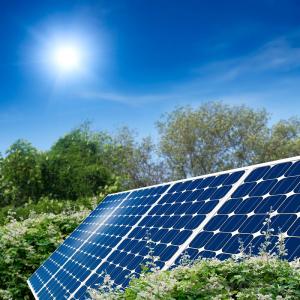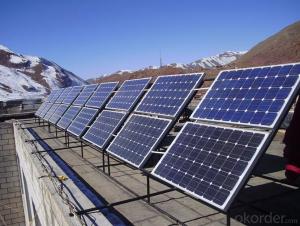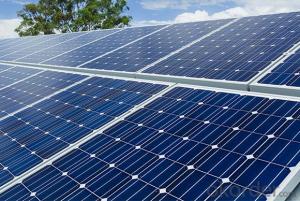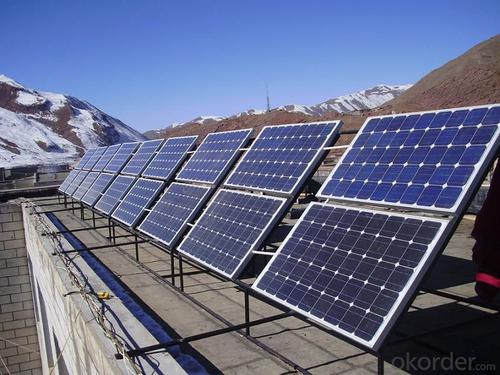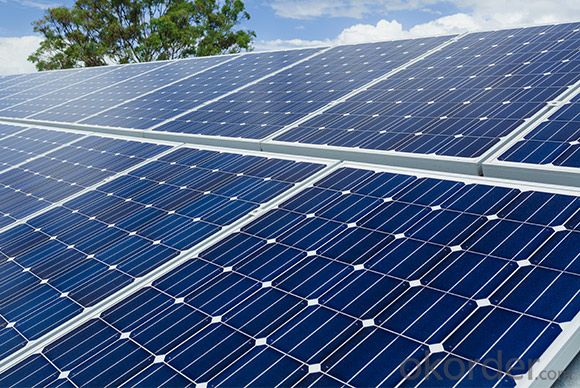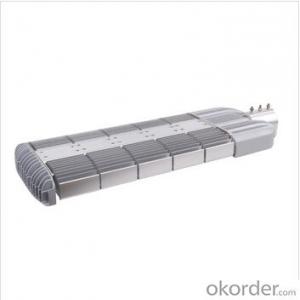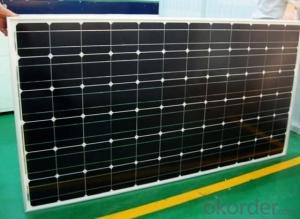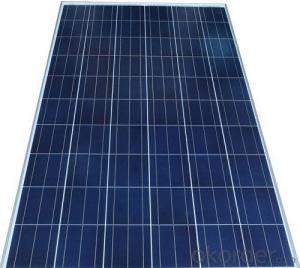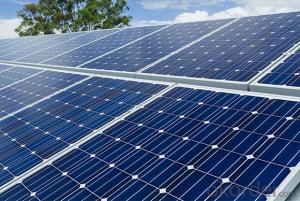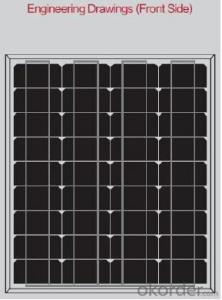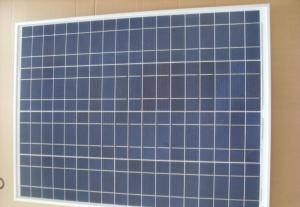Solar Panels Louisiana - CNBM Solar Monocrystalline 125mm Series (45W-50W)
- Loading Port:
- Shanghai
- Payment Terms:
- TT OR LC
- Min Order Qty:
- 100000 watt
- Supply Capability:
- 10000000 watt/month
OKorder Service Pledge
OKorder Financial Service
You Might Also Like
Product Description:
Mono-crystalline Solar Module Description:
Mono-crystalline solar moduleis the core part of solar power systems, as well as the most important part of the solar system. Mono-crystalline solar module consists of high efficiency crystalline silicon solar cell, super white cloth grain toughened glass, EVA, transparent TPT backboard and the composition of aluminum alloy frame. The function of Mono-crystalline solar module is to convert solar energy into electric energy, or sent to the storage battery, or promote work load. The quality of the solar energy battery components and cost will directly decide the quality and cost of the whole system.
Components
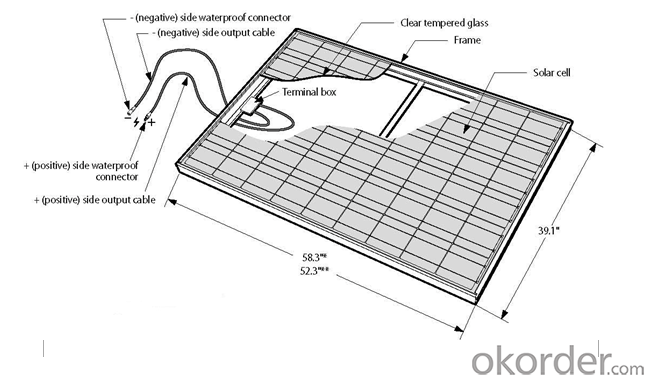
Data sheet
| Characteristics | |
| Max Power Voltage Vmp (V) | 17.4V-17.8V |
| Max Power Current Imp (A) | 2.59A-2.81A |
| Open Circuit Voltage Voc (V) | 22.4V-22.6V |
| Short Circuit Current Isc (A) | 2.75A-2.99A |
| Max Power Pm (W) | 45W-50W |
| Temperature Coefficient of Cells | |
| NOCT | 47℃±2℃ |
| Temperature Coefficients of Isc (%/℃) | 0.06% |
| Temperature Coefficients of Voc (%/℃) | -0.33% |
| Temperature Coefficients of Pmp (%/℃) | -0.45% |
| Mechanical Data | |
| Type of Cells (mm) | Mono125×62.5 |
| Dimension | 630×550×30mm |
| Weight | 4.5kg |
| NO.of Cells and Connections | 4×9=36 |
| Limits | |
| Operating Temperature | –45°C to +80°C |
| Storage Temperature | –45°C to +80°C |
| Max System Voltage | 700V |
FAQ:
1. How long will my inquiry get response?
Your inquiry related to our products or prices will be replied within 24 hours.
2. Can I get professional service and suggestion?
Well-trained and experienced staffs to answer all your questions in fluent English.
3. Do you accept OEM or customized design?
OEM & ODM, any your customized lightings we can help you to design and put into product.
4. What if I need specific design?
Distributorship are offered for your unique design and some our current models.
- Q: I'm a carpenter, and can do electric work. I want to make some money installing Solar Panels. what's the best source?
- a few months ago there was an article in pop sci about a company that has started to make solar panels at a fraction of the cost of what they used to be by using a printing style process instead of glass panel style they should hit the mass market soon that would be the best bet for a starting point to beat out price problems to allow a competitive edge they also had a article for low wind high power residential windmills for that could help in the alternative fuel push
- Q: So during the day, electricity is on, everything is on and working fine. But at night where there is no sunlight does all the electricity shut down for the night? So there is no light on for me during the night, or I can't watch tv at night? Is it also true that with solar panels, your bills are less expensive. Can someone please tell me these things
- My mum has solar panels and her electricity is still on all the time. If she uses stuff during the day, it doesn't cost her anything, as the panels are generating electricity, but at night if she uses things, then it will cost her coz there's no sun and no electricity being generated. She's still connected to the grid to use electricity but because she's feeding the electricity produced by her solar panels back into the grid the company pays her a certain amount for the no. of Watts that's produced. They cost a lot to install, but as she is generating more than she's using (even taking night time into account) she is being paid more back. e.g. before panels she paid ~?30per month. Now she receives ~?70per month. so she's about ?00 a month better off (coz she's saving the 30 AND being paid the 70 on top of that)! and will therefore gain the money back that she paid in in about 8 years or so. Hope that makes sense!
- Q: Pls is it ok to connect a 0watt and 20watt solar panel together into a charge controller port, can i just tie the wires together and run into the controller?? Will damage anything...Thanks guys
- Tobi, generally yes, solar panels are like beer, all the europeans get along fine, you can put two Belgiums in the same room as one German and three Englishman. As long as the panels have roughly the same open circuit voltage, usually around 8 volts, then go for it. If you're not sure about this, or the panels voltage disagrees dramatically, then they can still work through the same charge controller, the only other thing you need is a bypass diode in the junction box on the back of each panel. Most modern panels come with these already installed. They are simply electrical check valves, allowing current flow in one direction but not the other. The reason these matter is when the sun is first coming up, the higher voltage panel can force its power backwards through the lower voltage panel, at least until they both reach a voltage higher than the charge controller is set at. This is not a desirable thing to have happen, the 20 watt panel, if its voltage is higher, can damage the 0 watt panel without these diodes if the 20 watt has a much higher open circuit voltage, or Vmax. Look on the back of the panel for these ratings. The only other concern is maximum current. A charge controller has a maximum current it can handle, they are generally model numbered this way, a Xantrex C-60 for example has a 60 amp rating. Add up the Imax numbers on the back of all your panels, this is the maximum amperage the panel should put out. As long as it is not above 80% of your charger controllers maximum amperage, your good. Take care, Rudydoo
- Q: How much does it cost to replace a solar panel?
- The cost of replacing a solar panel can vary depending on the size, quality, and type of panel, as well as any additional installation costs. On average, a basic solar panel replacement can range from $500 to $1,500 per panel, but it's recommended to consult a solar installer or supplier for a more accurate estimate tailored to your specific needs.
- Q: I contend:As far as the solar panels causing global warming I'll try to explain. If you put a black panel on the ground or on your house and don't connect it to anything, it will absorb solar energy (heat) during daylight and release it at night (radiation). The net heat gain is zero. If you hook up a solar panel in the same place but hook it up to batteries, charge the batteries during sunlight hours and using that energy to electrically heat the home at night. The panels will absorb solar energy during the day but will convert that to electrical energy in the batteries instead of radiating it back into space at night. The result is a net gain in earth's temperature.Right or wrong?
- As far as it goes, you're right: putting up a big black object increases the total amount of energy absorbed from the sun. But that's only part of the story. If you didn't put up the solar panel, the same radiation would hit the earth. The earth already absorbs 2/3 or so of the energy that comes in (albedo .30), so adding even a perfectly black object increases it only by 50%. But it's not even that much, because most of the extra energy absorbed is converted into electricity. Solar panels are about 0-5% efficient, so half of the extra energy is turned into electricity rather than heat. Eventually it's put to use and turned into heat, but that heat was going to come from somewhere else anyway. (Even if it's just powering your DVD player, it turns into heat just the same as if you were using it to heat your house.) If you dig up a gallon of petroleum or fission a microgram of uranium, that's heat introduced into the earth's atmosphere. And these processes are inefficient: between generation and transmission you lose about 75% of the energy, meaning you've introduced 4 times as much energy into the atmosphere as you've actually used. So with a solar panel, you add extra heat to the earth by about 25% of incoming solar radiation, but you've offset external costs by about 45% of incoming solar radiation. The net effect is to cool the earth. And that assumes that the solar panel itself is perfectly black, which isn't the case. Real commercial solar panels have an albedo of about .35, which makes them more reflective than dirt and considerably more reflective than asphalt shingles, which have .03 albedo. In other words, even if you didn't actually use the solar panels for electricity, they'd be cooling the earth just by reflecting energy back into space more than your regular shingles.
- Q: Do they really save energy? Cut or almost eliminate your electricity bill, if so, how much?Do they have a reserve unit to save electricity that I don't use, to use when the sun is not out?Can it produce enough electricity to cool a house and keep lights and appliances runningLastly, how much are the panels are running for.
- It Can produce enough energy to run fans and yes keep the house cool. And if you also want to make one try it out. Good luck and save energy
- Q: If a solar panel is a .5kW system, what length of time is it putting out that much power? Every hour?
- Solar panels are rated under standard test conditions (STC), a certain amount of light at a certain distance, at a certain temperature, etc. A kW, or kilo watt, is 000 watts. So for the amount of time that the sun meets those conditions, the rate of output is 500 watts. An average location has an average of 5 sun hours a day, the total time that you produce the rated output. Watts is a rate, like miles per hour (mph), how fast it is going. Watt hours, or kilo watt hours (kwh) is a quantity, like miles. So if you drive 50 mph for 5 hours, you went 250 miles (50 mph x 5 hours). If you produce .5kw for 5 hours, you have the potential to produce 7.5kwh a day. Multiply that by 30 days in a month, you get 225kwh a month. In reality you will lose about 30% of the rated power from less than ideal weather, system losses, etc., so it's more like 50kwh a month. You can look at your electric bill to see how many kwh you use a month, maybe around 000kwh, and see what percentage of your usage a system like that can power.
- Q: Can solar panels be installed on a gas station or convenience store?
- Yes, solar panels can be installed on a gas station or convenience store. Installing solar panels on these establishments can help offset their energy consumption and reduce their carbon footprint. Additionally, it can lead to cost savings in the long run by generating clean and renewable energy.
- Q: What would it take to make a heater for a small solar panel. I am looking into making a heater for a livestock tank to keep ice melted. I know that heaters take alot of energy to run, but my theory is that if heated mirrors on a car can melt ice with low voltage and im sure not extreme heat (40-60 degrees) then making a heater with just high enough temperature to keep from icing over and melting ice is possible. Where do I start? I would like to use an inexpensive solar panel that will generate enough heat to keep ice from forming and melt it at the beginning of the day. How can you make such a heater and apply Ohms law so that it will function correctly, what Wattage will the pannel need to produce to generate enough heat for the heater. The device will only have to be large enough to melt a spot large enough for an animal to drink.
- Absolutely. But I see your point about the Ohms law. I think you'd need technical schematics to get the raw details.
- Q: Is this true in a dc system? What if my battery current is negative?
- Create okorder /
Send your message to us
Solar Panels Louisiana - CNBM Solar Monocrystalline 125mm Series (45W-50W)
- Loading Port:
- Shanghai
- Payment Terms:
- TT OR LC
- Min Order Qty:
- 100000 watt
- Supply Capability:
- 10000000 watt/month
OKorder Service Pledge
OKorder Financial Service
Similar products
Hot products
Hot Searches
Related keywords
